
The Steel-Cage: Need to reform the UPSC Civil Services Examination

Each year in India, an average of 4 lakh candidates appear for the Civil Services Examination (CSE) conducted by the Union Public Service Commission (UPSC). The notification for CSE 2021 has already been released by the UPSC, and the approximate number of vacancies is 712, a reduction from 796 in 2020 and 896 in 2019. The exam is for the recruitment of candidates for top administrative positions that are generalist in nature. Graduates and postgraduates from across the spectrum of higher education tend to compete in this examination. With the dream to become an Indian Administrative Service (IAS) officer, these candidates prefer to appear for a long-drawn-out examination process conducted by the UPSC every year. This essay argues that the nature of the UPSC CSE needs urgent reforms, as it presently contributes to the erosion of India’s precious human capital.
Opportunity cost
The opportunity cost of preparation for UPSC CSE is high. In economics, opportunity cost refers to the benefits that one decides to let-go, when one chooses one option over another. It incorporates both the explicit and implicit costs of the decision. When a candidate decides to appear for the UPSC CSE, he may forgo the immediate opportunities available in terms of jobs, career progression, better salaries, and higher studies. This is one part of the story. For the other half, one needs to calculate the cost of appearing for this examination. On average, the cost per aspirant is pegged around Rs.1.5 to 2 lacs just for coaching over the entire examination cycle. Adding the cost of living in metro cities that are the hub of the coaching industry, the entire cost can be around Rs.4 lacs per candidate for one attempt.
Now, let us put it in proper context. According to reports on data from the Household Consumer Expenditure Survey (2017-18) conducted by the National Statistical Office, the Monthly Per Capita Consumer Expenditure (MPCE) has reduced by 3.7% between 2011-12 and 2017-18.1 The decline was more in rural areas in India, as compared to the urban areas. In addition, the Periodic Labour Force Survey (PLFS) 2017-18 conducted by the National Sample Survey Office (NSSO) highlighted that the rate of unemployment in India has peaked to a 45 year high of 6.1%.2 The data also shows a summary decline in the Labour Force Participation Rate (LFPR) for people in the working age. This is surprisingly accompanied by a rise in the number of NEET individuals – Not in Education, Employment or Training. This is the group that the UPSC CSE aspirants belong to.
Considering the above data, one may conclude that in an economy with fewer jobs, declining household income and expenditure, the precious human and economic capital in the country is diverted to the preparation of UPSC CSE, with all its subjectivity and uncertainty. The question is- why do the aspirants not realise this and make a course correction when necessary?
Sunk Cost & the Vicious Circle
The three-stage examination cycle consisting of the Preliminary examination, the Main examination and the Personality Interview, stretches for one complete year. The preparation, due to the syllabus & the fierce competition, generally requires dedicated study of at least 8 to 12 months, prior to the preliminary stage. In effect, any serious candidate taking the first attempt at the CSE would be required to study for nearly 2 years to complete one examination cycle. If they fail to qualify in any of these three stages, they are required to undergo the entire examination cycle again the following year if they choose to do so. Also, the score obtained in the examination in one particular year is valid only for that year. This ensures that the sunk cost becomes extremely high for the aspirant, as the number of attempts taken at the examination increases. Sunk Cost is a retrospective cost that has already been incurred and cannot be recovered. Thus, with each additional attempt, the aspirant gets entrenched deeper and deeper in this vicious cycle of successive stages of the examination. The subjective nature of the examination and the lack of objective self-evaluation by the candidates, makes them discard the risk involved and they continue to chase the mirage of becoming an IAS, year after year. (See Fig.1)
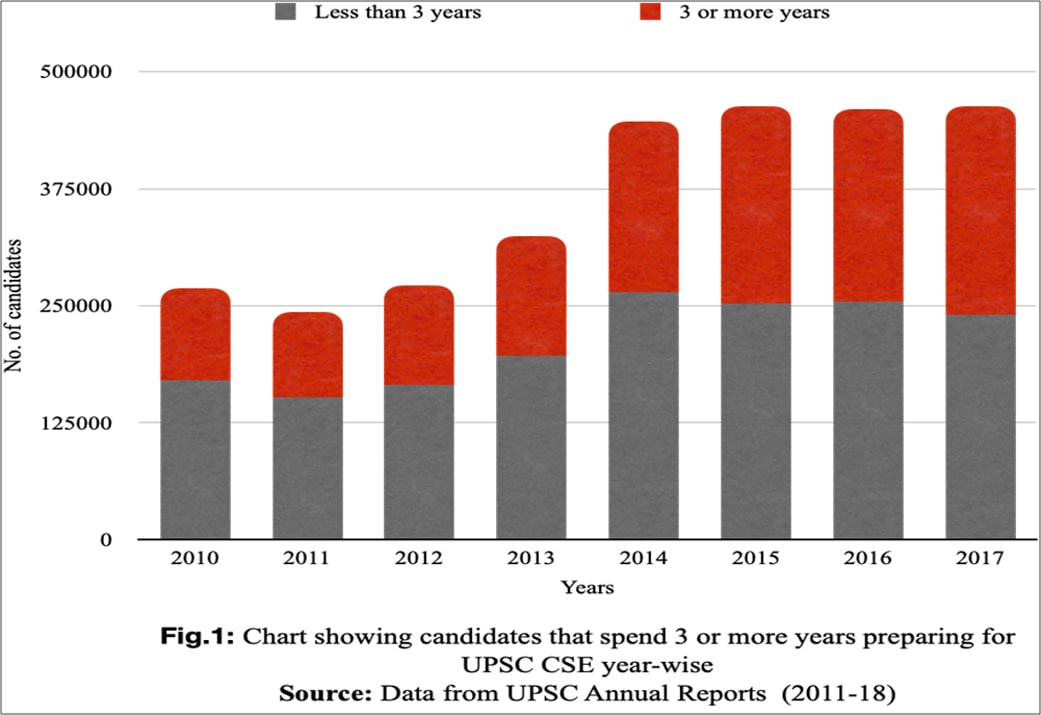
Erosion of Skills
According to the latest Annual Report (2018-19) published by the UPSC, among the candidates recommended by UPSC as per the final merit list, 77.7% were graduates while 22.3% were post-graduates. The analysis of their graduation and optional subjects for the CSE is shown in the figure below.
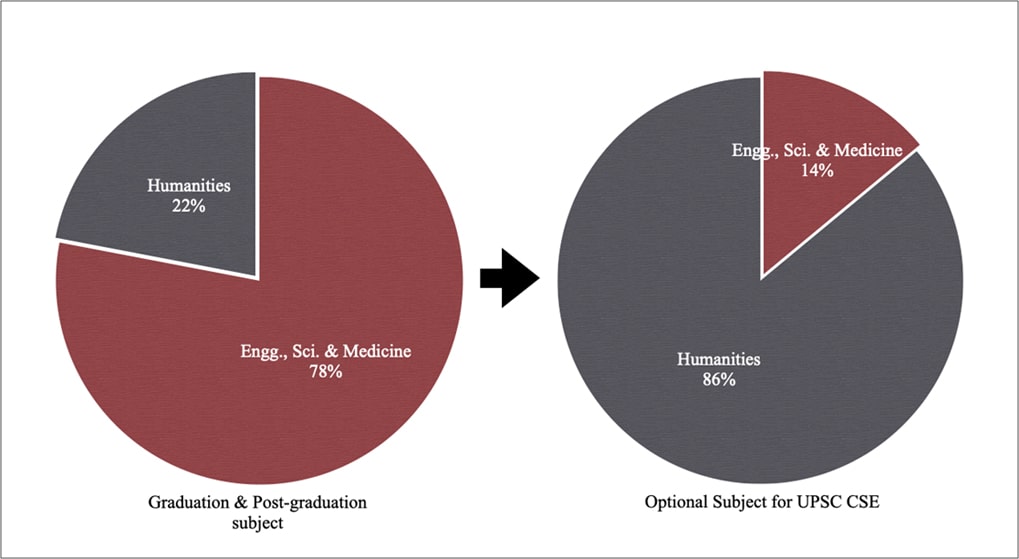
Fig.2. The cross-domain shift by recommended candidates
Source: Data for recommended candidates from UPSC Annual Report (2018-19)
Extrapolating this to all aspirants for the CSE, it can be concluded that the majority of the science, engineering and medical graduates make a cross-domain shift from their original background subject (technical/professional) to humanities subjects while appearing for the CSE.3 This shift is based on the assumption that it is easy to complete the study and score better in the examination taking the humanities subjects like geography, political science, anthropology, etc. as optional subjects, rather than their original graduation stream. Also, not all science and technical graduation subjects are included by UPSC as choices for selecting the optional subject. The bad news is—most of these candidates making the cross-domain shift don’t qualify!
Not only is the human capital non-utilised, but the long-drawn-out process of examination also erodes the domain-specific abilities and skills acquired by the candidates during their graduation. Without giving due consideration to their aptitude, interest or their skills, a large number of educated youth continue to be lured by the power, prestige and aura surrounding the IAS and the allied services.
Most candidates who take multiple attempts at this examination unsuccessfully, continue to drain the resources of their families, while themselves becoming unfit for the rapidly evolving techno-economic milieu in the job market. This needs to change, especially considering the Covid-19 pandemic and its adverse impact on the Indian economy and society. With declining incomes, depleting assets, rising poverty and uncertainties about their livelihoods, the fate of the aspirants and their families cannot be subjected to the cruelty of an examination system that robs them of their hard-earned savings, their productive energies, and their professional skills. Is this cost justified? Let us take a look at the relevant numbers.
The problem
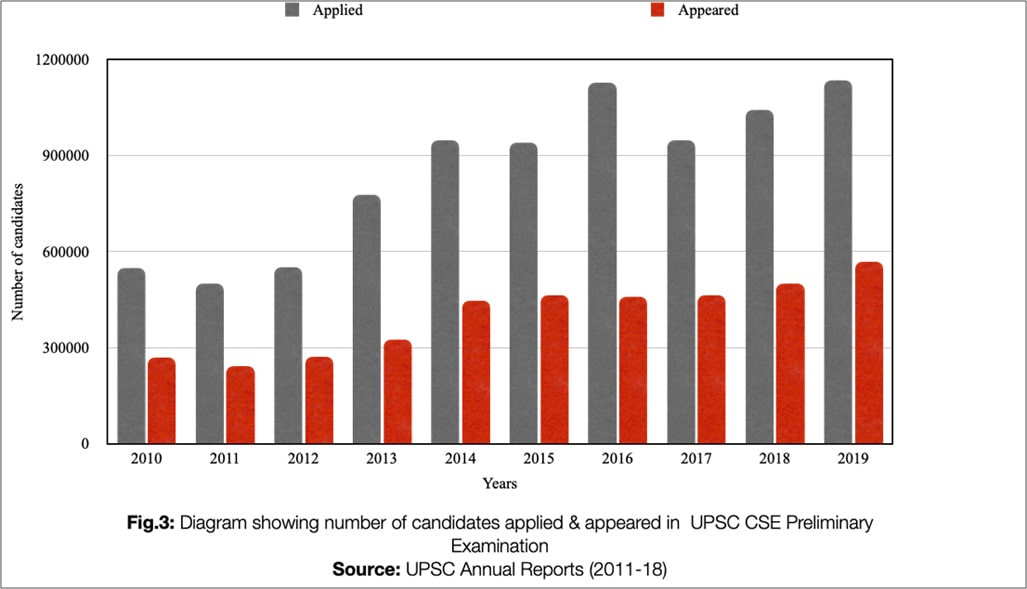
With a youthful demographic profile, burgeoning middle-class, the explosion of aspirations, and the lack of commensurate increase in good-paying job opportunities in the market, the number of candidates appearing in the UPSC CSE each year has remained at a very high level as compared to the aggregate posts available (See Fig.3 and Fig.4). In addition, the number of final selections every year have remained nearly stagnant at around 1,000, as data from the last decade indicates. The only exception was the year 2014 when vacancies rose to 1,364, probably the result of a populist step by the government facing a highly contested general election that year.
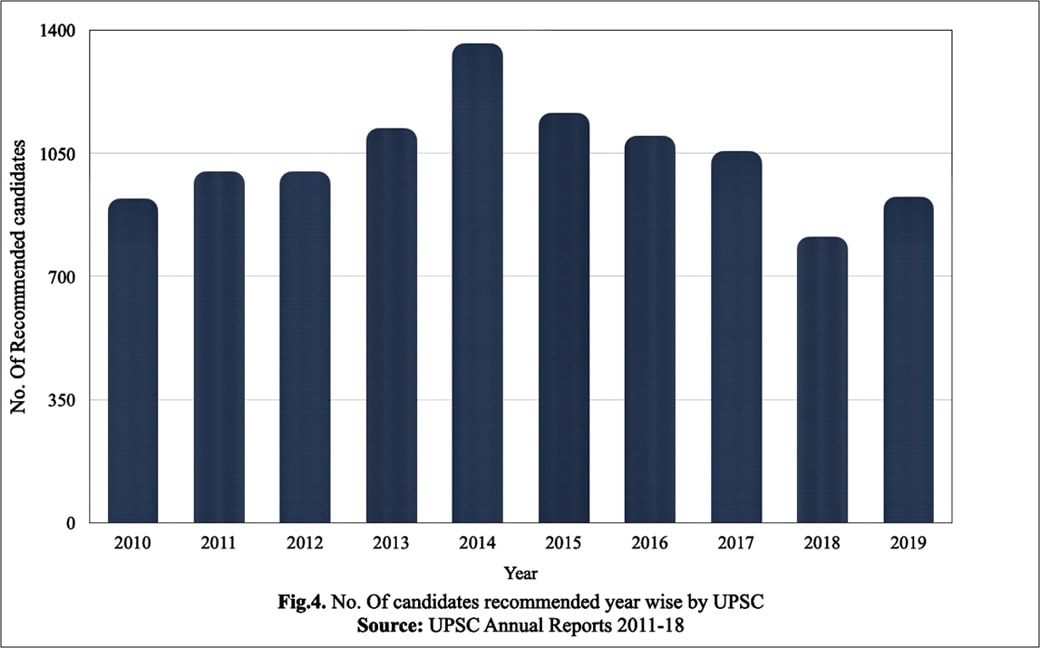
Each candidate appears for the Civil Service Examination with his or her sight firmly set on the top two or three services. The rate of selection in this examination is declining consistently over the years, as the vacancies decrease and the number of aspirants increases (See Fig.5). The average percentage of selection is 0.28%. The rejection rate is 99.72%. Among those selected, the percentage of candidates getting the top services, effectively considered the service of their choice, is approximately around 25%. This means that nearly 75% of the candidates who qualify the rigorous UPSC CSE do not get their preferred service allocation. This forces many of these candidates to reappear in the examination for improving their ranks the following year. Thus, even for those who have qualified the examination, albeit with a lower than expected rank, the process of examination does not effectively end. And after so much effort, if they are forced to accept the service they are already in, how motivated would these officers be to do justice to their role?
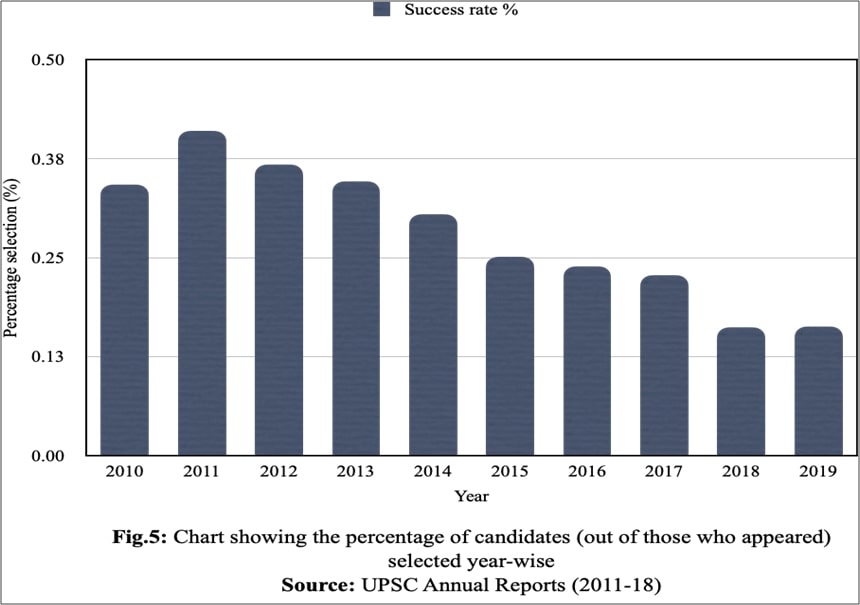
For a general category candidate, the number of attempts permitted in CSE is six, and the maximum permissible age limit is 32 years. Both these parameters are relaxed for Other Backward Classes (OBCs) and SC/ST candidates. This means, the cumulative number of unsuccessful candidates that keep on appearing for the civil services examination, both at the Centre and State levels, goes on increasing each year. This talent, locked for 4-5 years in a pipeline, without a good job or hard skills, is a loss of precious human capital that our country cannot afford.
A common examination system with a generalist bias
The UPSC is a constitutional body and a central recruiting agency. Through the Civil Services Examination conducted each year, selected candidates are allocated across 19 different services. In effect, the same examination, process and yardstick is being applied to select candidates who would be working as officers in Indian Foreign Service, Indian Administrative Service, Indian Police Service and the Indian Revenue Service and so on. Though a candidate is required to indicate service priority in his/her application form, the process doesn’t take into consideration the aptitude of the candidate while the service is being allotted, as the allotment process follows the merit-cum-rank basis in the common examination.
After their selection, the candidates are trained to be generalist officers handling various administrative posts in the government. The post allotted and the nature of work may be completely different not only from the educational background of the candidate, but also his/her aptitude and interest. For example, a graduate or postgraduate student from literature background and interested in Indian Foreign Service, may get allocated to, and be required to work in the central audit & accounts department or the Income Tax department. This raises serious questions about person-job fit.
The cost of failure
The Administrative Reforms Commission-II (10th report) discusses the problem of loss of human capital due to the structure of the UPSC CSE.4 After aspirants have exhausted their attempts at the CSE, they attempt to re-enter the market. It is important to realise that the resources spent on the education and training of the rejected 99.72% of the candidates do not get the desired output and outcome in the economy. Apart from the financial cost that the families of these candidates are forced to bear, there is a tremendous psychological cost that these candidates pay during and after the process of examination is over. Having exhausted their 4-5 years in preparation, the 99.72% candidates are then forced to confront the harsh realities of a ruthless job market. These aspirants find it difficult to return back to their professional fields and thus, settle for various posts advertised by the State Service Commissions, Staff Selection Commission and the Banking sector, etc. The sheer number of candidates generates cut-throat competition for these posts too, further consuming the aspirants time.
These candidates, having taken a long gap to prepare for the CSE, do not have any certificate or degree which justifies this gap, nor any tangible experience or skill, that may make them eligible for employment elsewhere. This takes a toll on their productivity, self-confidence and their emotional health, as they are battered by repeated setbacks in the examination process. In essence, when the advancement in technology has brought the world on a cusp of change, the professionals in India are chasing the mirage of ‘permanent’ government jobs. And in this tussle to enter the formal public sector, the demographic dividend of India could be inadvertently turning to informal jobs. Not to forget the fact that these candidates, the graduates and the post-graduates, represent the fortunate one-fourth of their age cohort, who get an opportunity for higher education in India. This precious human resource gets trapped in the vicious circle of repeated attempts at UPSC CSE, while remaining voluntarily unemployed and economically dependent.
What can be done to address the issue?
The Covid-19 pandemic has exposed the inefficiencies in the rigid administrative system in India. It has also highlighted the limitations of the Consultant Culture that most ministries and departments in the government have opted for. The process of reform has to begin with the reforms in the system of examination. The provision of lateral entry cannot be the substitute for administrative reforms.
First, the Civil Services Examination, in its present form, needs unbundling.5 The services need to be grouped on the basis of the required skills and aptitude. The Stage-1 Examination can be common for all the services, whereas the Stage-2 Examination can be organised separately for different groups of services. This will curtail the generalist nature of the process and make it more specialised and focussed. The Detailed Application Form, submitted by aspirants to the UPSC, should emphasise on aspirants’ skills rather than being just a summary of their personal information.
Second, the Preliminary stage of the UPSC CSE can be conducted as a Stage-1 standardised computer-based online test, the scores of which can be held valid for at least two years.5 For Stage-2 and Stage-3, the results can be considered as valid only for that particular examination cycle. The questions in Stage-1 can be based on Current Affairs, Critical Thinking, Quantitative Aptitude, Logical Reasoning, Analytical Skills, Data interpretation and English Comprehension. This Stage-1 examination may be conducted at least twice a year, to save the candidates time and effort.
As the results of Stage-1 can be obtained in real-time, the Main Examination i.e. Stage-2, for various groups of services can be conducted within 45-60 days after the preliminary examination. The syllabus for the Stage-2 examination can be curated separately for each group of Service, making it more relevant to the Service requirements. This Stage-2 examination should also be conducted in the online format, based on a syllabus covering the relevant areas for the Service concerned, in addition to General Studies, Case Studies, Ethics & Aptitude. Stage-3 of the examination can be the Personality Test combined with a descriptive Essay Paper. This would help shorten the examination cycle. In this format, UPSC can conduct the Civil Service Examination twice a year. This would require adjustments in the training schedule at the Service Training Academies to allow for the intake of selected candidates twice a year.
Third, the age-limit can be upto 28 years for general category, with relaxations for the disadvantaged sections. This age-limit is more than what has been recommended by various civil service reforms committees, like Y.K Alagh Committee (recommended age-limit of 26 years), P.C Hota Committee (recommended age-limit of 24 years), the 10th Report ‘Refurbishing of Personnel Administration & Scaling New Heights’ of ARC-II (recommended age-limit of 25 years), Baswan Committee (recommended age-limit of 26 years) and recently, the India@75 Report by the NITI Aayog (recommended age-limit of 27 years).6 This would help address the concerns of aspirants from rural areas, who would get sufficient time for preparation. The number of permissible attempts for aspirants must be reduced to three, which would not consume more than 2-3 years for any serious candidate, in the new format of the examination.
Fourth, the mandatory requirement of choosing an Optional Subject must be done away with.7 This would eliminate the cross-domain shift from professional and technical courses to humanities subjects. The optional subject paper does not specifically measure the suitability of the candidate for an administrative role. Eliminating it would reduce the cost of preparation for the aspirant and make the process more relevant and less time-consuming.
Lastly, it is needless to emphasize the need and significance of technology in the present governance architecture. The UPSC CSE should require from the aspirants a certain level of proficiency in digital skills. This can act as a signal for the aspirants who would then consider obtaining competence in these skills, thus increasing their job readiness.
Such a scheme of examination would minimise the dead-weight loss to the economy, and still attract and retain the best talent for service to the nation. As the eligibility criteria would still remain graduation, the exam system would successfully bring in candidates from diverse backgrounds into the services. The shorter and relatively flexible examination cycle would help aspirants to seek alternative opportunities in education or job, without wasting much time, effort and money.
The above mentioned steps would also help break the draconian grip of the coaching industry that has mushroomed throughout the country for the existing pattern of the CSE. Most of these commercial coaching institutes create a larger than life image of the IAS and sell this dream to the aspirational youth. They tend to misguide the candidate, keeping him/her in the phase of preparation perpetually, till the candidate exhausts either the money, age limit or the total available attempts for taking this examination.
These measures would keep the competitive spirit of the UPSC CSE intact, but would reduce the loss — to the candidate, to the economy, to the society and to the nation. The structure of the examination would be flexible enough to allow talent to flow in and the non-performers to be weeded out easily. By reducing the uncertainty and the overall cost of the examination to the candidate, the new system will ensure that the officers selected would be more eager to learn and adapt, once they get into the service. The public services, in effect, would become more agile and outcome-oriented. The officers chosen would be better suited to deal with the complex challenges of 21st century India. The whole process would be dynamic and discourage preparation in silos, thus, better utilising the human capital for value creation in the Indian economy and society. It is high time that the colonial constructs of the UPSC CSE —the Steel Cage; and the Indian Administrative Service—the Steel Frame, are restructured to be more responsive to the needs and aspirations of the youth and the nation.
The views expressed in the post are those of the author and in no way reflect those of the ISPP Policy Review or the Indian School of Public Policy. Images via open source.
References:
- Jha.S. (2019 Nov.16). “Govt scraps NSO’s consumer expenditure survey over ‘data quality’.” Business Standard. Retrieved from https://www.business-standard.com/article/economy-policy/govt-scraps-nso-s-consumer-expenditure-survey-over-data-quality-119111501838_1.html
- Jha.S (2019 Feb.6). “Unemployment rate at four-decade high of 6.1% in 2017-18: NSSO survey.”Business Standard. Retrieved from https://www.business-standard.com/article/economy-policy/unemployment-rate-at-five-decade-high-of-6-1-in-2017-18-nsso-survey-119013100053_1.html
- Union Public Service Commission. (2011-2019). The Annual Reports 62nd to 69th. https://www.upsc.gov.in/annual-reports
- The Second Administrative Reforms Commission 10th Report. (Nov. 2008). Refurbishing of Personnel Administration- Scaling New Heights. https://darpg.gov.in/sites/default/files/personnel_administration10.pdf
- Nigavekar.A. et al. (2012 August 30). Committee on Civil Services Examination Reforms. Retrieved from https://www.upsc.gov.in/sites/default/files/Sl-023-ArunNigvekarCommitteeReport-2012_0.pdf
- NITI Aayog. (November 2018). Strategy for New India @ 75. http://niti.gov.in/sites/default/files/2019-01/Strategy_for_New_India_0.pdf
- Baswan. B.S. et al. (9 Aug. 2016). To take a comprehensive look at the requirement of IAS Officers over a longer time-frame. https://dopt.gov.in/sites/default/files/BaswanReport.pdf
FAQs
Why do we need civil service reform?
Civil Service Reform aims to enhance the administrative capabilities required to carry out fundamental government responsibilities. These reforms improve the quality of services provided to citizens, which is crucial for promoting sustainable economic and social development.
What is the name of the new civil services reforms?
Prime Minister Narendra Modi chaired a meeting of the Union Cabinet, which approved the “Mission Karmayogi” – a new National Architecture for Civil Services Capacity Building. The goal of this initiative is to revamp the capacity-building mechanism at the individual, institutional, and process levels within the Government of India.
What are the three main Civil Services in India?
The All India Services include three prestigious civil services in India, namely the Indian Administrative Service (IAS), Indian Police Service (IPS), and Indian Forest Service (IFS).
Why are civil services important?
- Basis of Government – The government can not exist without administrative machinery.
- Implementing Laws & Policies – It is the civil services’ responsibility to implement laws and execute policies framed by the government.
- Policy Formulation – The civil service is also chiefly responsible for policy formulation.
Dr. Kaustubh Bondre
Dr. Kaustubh Bondre is a medical graduate from GMCH, Nagpur. He has studied Post-Graduate Program in Policy Design & Management at ISPP, New Delhi. Presently, he is working as a Research Associate with Adhyayan Quality Education Foundation, Mumbai, and also as an Adjunct Professor with MIT-WPU School of Public Policy, Pune. He is passionate about education, health and international affairs. An avid reader and a travel enthusiast, he has also worked in Kulgam (Kashmir) and Naharlagun (Arunachal Pradesh) for designing training programs for students. He believes in the need for bringing ‘public’ back to the heart of public policy in India.

